AMD Radeon HD 7870 GHz Edition & Radeon HD 7850 Review: Rounding Out Southern Islands
by Ryan Smith on March 5, 2012 12:01 AM ESTPower, Temperature, & Noise
As always, we wrap up our look at a new video card with a look at the physical performance attributes: power consumption, temperatures, and noise. Thanks to TSMC’s 28nm process AMD has been able to offer 6900 series performance on a much smaller chip, but what has that done to power consumption and all of its related properties? Let’s find out.
Please note that we’re including our 7870-based 7850 in these charts, even though none of AMD’s partners will be shipping a card in this exact configuration. Power consumption should be nearly identical to shipping cards, but temperatures and noise readings are going to be significantly different since most of those cards will be using open air coolers.
| Radeon HD 7800 Series Voltages | ||||
| Ref 7870 Load | Ref 7850 Load | Ref 7870 Idle | ||
| 1.219v | 1.213v | 0.85v | ||
When getting a voltage reading on our 7800 cards through GPU-Z, it was interesting to note that the load voltage was almost identical between the two cards: 1.219v versus 1.213v. While we believe GPU-Z is giving us the right readings, we’re not sure whether the 7850 voltages are the same we’ll be seeing on shipping cards because of the PCB differences.

Idle power consumption looks quite good, as you’d expect from GCN. Idle power consumption is virtually identical to the 7900 series at the wall, and only the 7700 series can beat 112W. This further goes to show just how much progress has been made with idle power consumption – the Cayman based 6900 series had good idle power consumption for its time, and yet the 7800 series beats it by 5W+ at the wall.
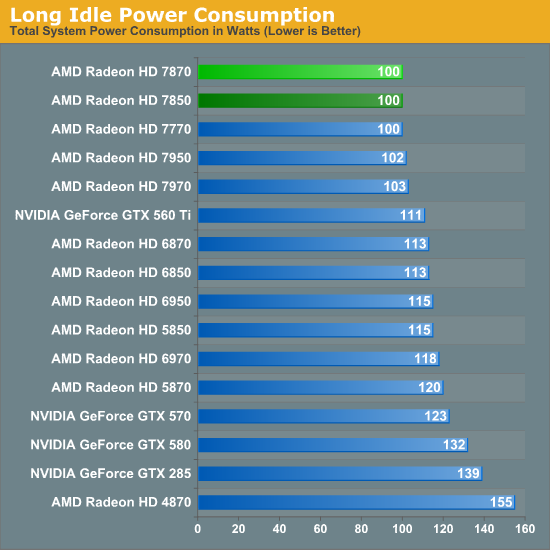
Long idle power consumption is virtually identical with the rest of the Southern Islands cards thanks to AMD’s ZeroCore Power technology. The next closest card is the GTX 560 Ti, and that’s at nearly 10W higher.
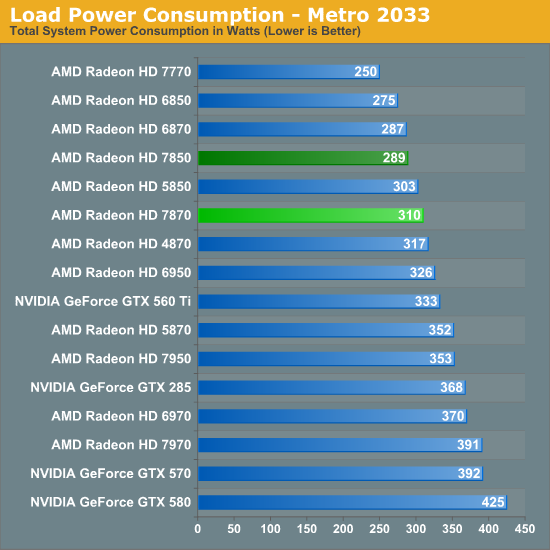
Moving on to load power testing, we have Metro 2033. Load power consumption here is about where you’d expect it to be, with the 7800 setups drawing more at the wall than the 6800 setups, but less than the 7900 and 6900 series. This is largely a consequence of performance, as the higher rendering performance of the 7800 series versus the 6800 series drives up CPU power consumption in order to generate more frames.
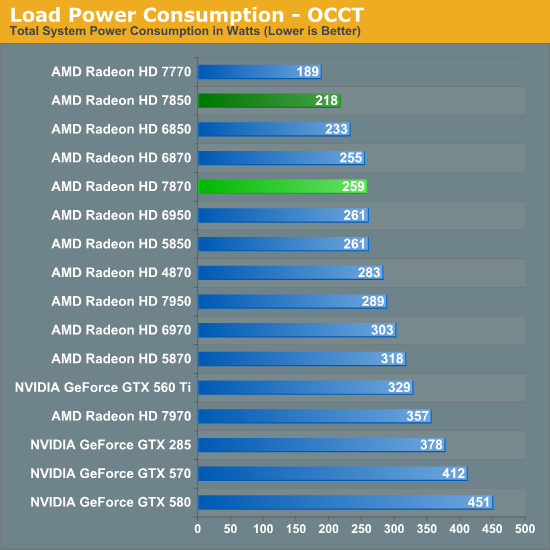
OCCT on the other hand gives us a more purified look at power consumption, and as you’d expect for 28nm it looks good. The 7870 ends up drawing only a few more watts at the wall compared to the 6870, showcasing the fact that the 7800 series is a drop-in replacement for the 6800 series from a power consumption perspective. The 7850 looks even better, capping out at 15W below the 6850, most likely as a result of PowerTune keeping the card firmly at 150W. Though it’s interesting to note that the measurements at the wall don’t perfectly align with the differences in PowerTune limits, with the 7850 drawing 30W more than the 7770 at the wall compared to a 50W PT difference, while the 7950 draws 30W more at the wall over the 7870 even though there’s only supposed to be a 10W PT difference.
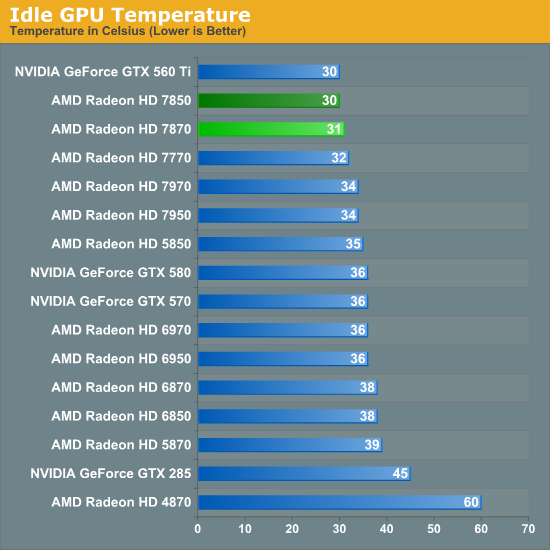
AMD’s latest generation blowers do quite well with idle temperatures and we can see it here. At 30C for the 7850 it’s every bit as cool as the GTX 560 Ti, while the entire 7800 series is around 5-8C cooler than the 6900.
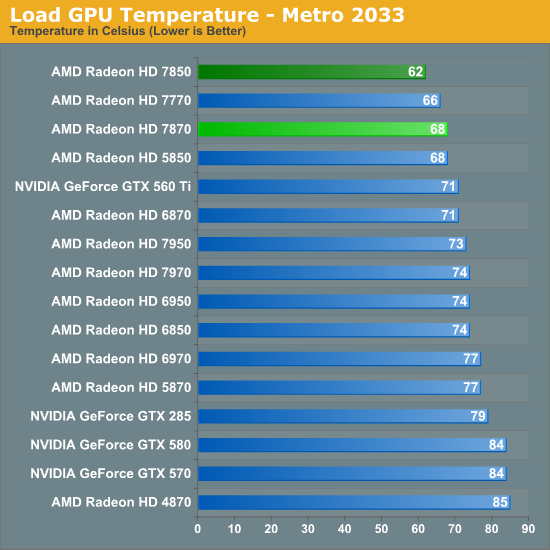
Under load, Metro temperatures are also quite good. At 62C the 7850 is the coolest card in this performance class, but keep in mind that it’s basically using an oversized cooler; retail cards will be open air coolers with much different characteristics. Otherwise at 68C the 7870 is still among the coolest cards, coming ahead of even the historically cool GTX 560 Ti, never mind the much hotter 6900 series.

Load temperatures climb under OCCT, but again the 7800 series is among the coolest temperatures we see. Here we see the 7870 peak at 73C, whereas its last generation counterpart would be at 80C and the GTX 570 at a toasty 87C.
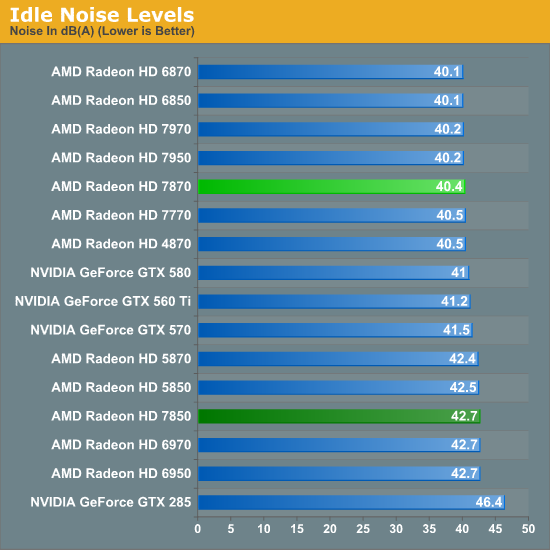
Moving on to noise testing, there are no major surprises at idle, with the 7870 hugging 40db. For whatever reason the 7850’s minimum fan state is roughly 200RPM higher than the 7870’s, but since no one will be using this cooler it’s not a significant result.
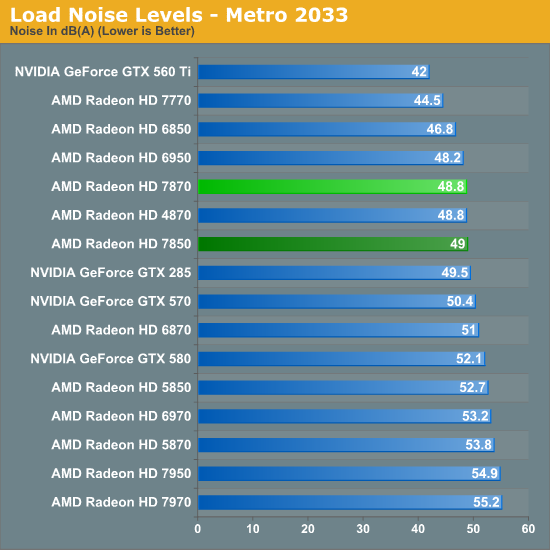
Consistent with AMD’s other 7000 series cards, we’re once again seeing the consequences of AMD’s aggressive cooling policies coupled with the use of a blower. At 48.8dB the 7870 is still quieter than the blower-based 6870, but it’s significantly louder than the open air cooled GTX 560 Ti, even though the latter consumes far more power and generates far more heat. This doesn’t make the use of a blower the wrong choice, but combined with aggressive cooling policies it does hurt AMD. The GTX 570, in spite of using much more power than the 7870, is only less than 2dB louder even though it too uses a blower.

Last, but not least we have our OCCT noise results. Unlike Metro the 7800 series does better on a relative basis here, but this is mostly because NVIDIA doesn’t have a power throttling system quite like PowerTune. At 51.9dB the 7870 is not the quietest card, but it still manages to beat the 6970 and the PowerTune-less 6870.
All things considered there are no great surprises here on a relative basis, as the 7800 series performs like we’d expect for a blower based sub-200W video card. Due to TSMC's 28nm process AMD greatly improves on their performance/power and performance/noise ratios with the 7800 series compared to the 6800 and 6900 series, while for their power class the 7800 series is slightly ahead of the pack on both power consumption and noise.
With that said, keep in mind that since most of AMD’s partners will be using open air coolers these results won’t be applicable to most retail cards. So for the temp/noise characteristics of retail cards you’ll want to look at individual card reviews when those start appearing later this month. This is particularly true for the 7950, where all of the retail cards will be using a different design than our sample.










173 Comments
View All Comments
Galidou - Monday, March 5, 2012 - link
Yep, this must be the best price/performance ratio the 7xxx series has to offer yet but still nothing worth of buying unless you got a 3 years old plus video card...7870 priced at 300$ I wouldn't mind changing my 6850 crossfire for one of those considering the wattage and temperature of my actual setup. I was considering a gtx580 as they can be found on ebay for around 400$ used but this 7870 is around the same in every game I play at the resolution I play them. Plus the 2gb memory and cheaper price tag for a new one...
But I'll still wait for the price to drop or switch to kepler if price/performance is amazing... Heard it should be but it's all speculation on something that's not out yet...
chizow - Tuesday, March 6, 2012 - link
Only took 4th product launch from AMD for you to see what I was saying was true, but better late than never. ;)But yeah the real value right now is the last-gen parts going EOL and selling for extremely low prices. The 6950/6970s are mostly dried up in the channel, but there were GTX 480s for $219 last week, up next on the chopping block should be the 560Ti448/570/580 for great prices ahead of Kepler's launch.
Galidou - Tuesday, March 6, 2012 - link
I never said that you were totally wrong, I was only saying that it's not the worst thing that's ever happened in computer's history, while you were making a freaking case of it because I spoke against Nvidia...And you still can't name even an older radeon card in your short list of cheap video cards to get... At 130$ and 160$ for a radeon 6850 and 6870 respectively you still get ALOT for what you pay for. Radeon 6870 isn't far from gtx 560ti. Why mentioning it when you're being paid by the green goblin, they would stop sending your fanboy checks I guess, just teasing :P
There's one thing extraordinary about this gen, the size plus wattage used for THAT kind of performance... is quite amazing, it should just be priced accordingly to it's die size and it would be dirt cheap LOL... but no bang for your bucks here...while in this segment of the market where you usually ''get it all'' about price/performance ratio. Lower the price of 50$ for every 7xxx video card and it will be ALOT better.
BPB - Monday, March 5, 2012 - link
If nothing else I gotta believe that the new nVidia cards will force a quick price adjustment from AMD. I think we'll see the AMD cards drop $25 to $50 when the nvidia cards come out.CeriseCogburn - Friday, March 9, 2012 - link
After running blackbox 2.3 and wenning to the Turkish site I find something very interesting on Kepler:" Nvidia 's next-generation family of Kepler frequencies, dynamic graphics cards needed to improve their own work. Rumor has officially been confirmed as yet have the ability to dynamically overclock Kepler cards will leave a strong impact in the markets."
--
LOL - Dynamic Overclocking of Kepler similar to Intel turbo... very nice Nvidia...
http://translate.google.com/translate?hl=en&sl...
mak360 - Monday, March 5, 2012 - link
"but $199 for a GTX 560 Ti is going to be hard to pass up while it lasts" I see you have to get a boot in there to AMD when possible. lolMost of the games are nvidia optimized where the 7850 loses one or two to the 560ti old tech.
AMD`s been quite merciful to nvidia in regards to price points, when nvidia brings it on and the same happens (cards slot in without a challenge to AMD) I call shady business between the two or they don`t want to compete with each other, which is understandable i guess..
Or maybe people need to forget the past and move on with "oh how nice and cheap prices were"
sofreshsoclean2 - Monday, March 5, 2012 - link
smoking card, faster than the 6970, fast as a gtx580 in a lot of those test but 150 smackeroos cheaper It is very close 7950 as well, finally a super fast card that is not 500 bucks. amazing card!! and nice review.thanks
Devoteicon - Monday, March 5, 2012 - link
Upgrade my overclocked 5850 for one of these? Thanks but no thanks.geniusloci - Monday, March 5, 2012 - link
I'm going to be getting one or the other. I'll have to decide if the 7870 is worth the additional cash or not. They will most assuredly drop in price once Nvidia launches its product. Having come from a 560Ti this will feel something like a side grade in performance, but having found out how much better ATIs cards do 2D and video I simply can't return to the blurry mess which is Nvidia right now.Kiste - Monday, March 5, 2012 - link
So it's 2012 and AMD gives us two cards that do little more than match the GTX 570 and 580 in price/performance.Southern Island has been a huge disappointment so far.